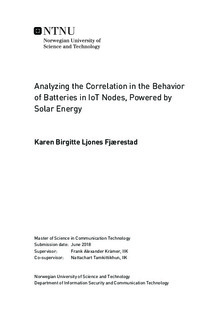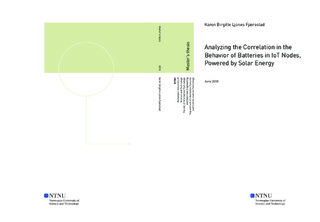| dc.description.abstract | In the technological world we live in today, Internet of Things (IoT) isbecoming more prominent. IoT uses sensor nodes in order to perform theintended task, and these sensor nodes need power. When powering IoTnodes, the usage of rechargeable batteries is the most common method.Batteries that are rechargeable, charges and discharges several timesduring their life cycle. This charging and discharging is for this projectconsidered to be the behavior of the battery. For this master theses theobject is to analyze the correlation in the behavior of batteries. To see ifthere is any correlation, and if there is, if this behavior can be predicted.
The experimenting conducted in this master thesis is testing whethermachine learning models may be used to predict the behavior of thebatteries in IoT nodes. Eight sensor nodes were placed outside on theroof, and these sensors were sending measurements at constant intervals.The sensor nodes are powered by batteries that are connected to solarpower panels. These solar power panels are responsible for the chargingof the batteries. There exists many machine learning models, so thereforthe first the task was to figure out which of these models could be usedfor the problem at hand. Six machine learning models were chosen forthe testing. The testing was done by creating the models with the help ofprogramming code, and then running this code in the computer terminal.As a basis for the testing, large datasets with measurements from each ofthe batteries was used. These large datasets were created into trainingsets for the machine learning models to learn from in order to makepredictions. After all the models had made their prediction, the task wasto analyze these predictions to see if any of the models could be utilizedfor this type of problem.
From analyzing the data sent from the batteries, it was evident thatthere can be a correlation between the behavior in batteries. This ishowever dependent on which way the solar panel for the battery is facing.For northern places where the weather is unreliable, the panels have to befacing south in order for the batteries to charge correctly. Using machinelearning models to predict the future behavior of batteries also proved tobe plausible. Even though all the models did not work for the purposeintended, some of the models matched the actual data very well. Tosum up, there is a correlation in the behavior of batteries if the batteriesare charged at an even rate. This charging can be obtained if the solarpanels are facing the correct way. Machine learning is a very good toolfor predicting future behavior of batteries, if the right model is chosen. | |

